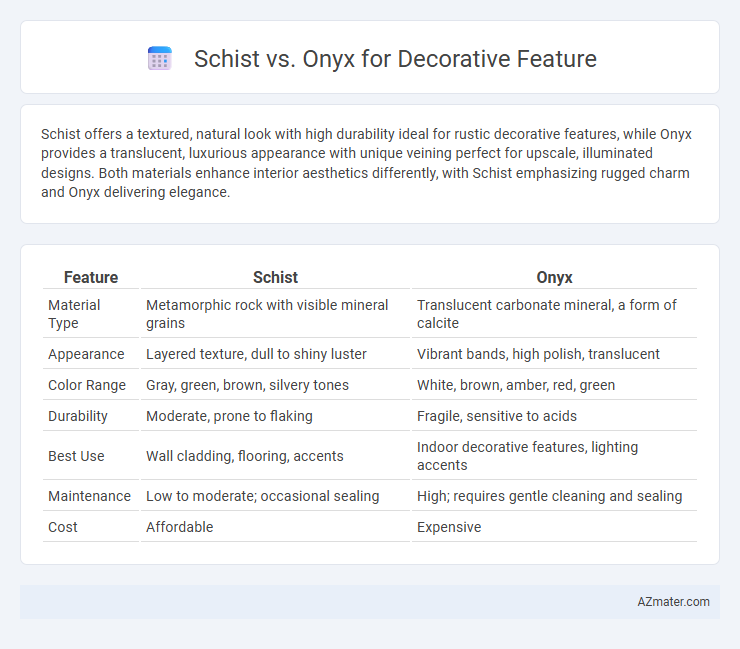Schist offers a textured, natural look with high durability ideal for rustic decorative features, while Onyx provides a translucent, luxurious appearance with unique veining perfect for upscale, illuminated designs. Both materials enhance interior aesthetics differently, with Schist emphasizing rugged charm and Onyx delivering elegance.
Table of Comparison
| Feature | Schist | Onyx |
|---|---|---|
| Material Type | Metamorphic rock with visible mineral grains | Translucent carbonate mineral, a form of calcite |
| Appearance | Layered texture, dull to shiny luster | Vibrant bands, high polish, translucent |
| Color Range | Gray, green, brown, silvery tones | White, brown, amber, red, green |
| Durability | Moderate, prone to flaking | Fragile, sensitive to acids |
| Best Use | Wall cladding, flooring, accents | Indoor decorative features, lighting accents |
| Maintenance | Low to moderate; occasional sealing | High; requires gentle cleaning and sealing |
| Cost | Affordable | Expensive |
Introduction to Schist and Onyx
Schist is a metamorphic rock characterized by its foliated texture and vibrant mineral grains, making it a durable and visually appealing choice for decorative features. Onyx is a banded variety of chalcedony known for its smooth, translucent layers and striking color contrasts, favored in interior design for its luxurious appearance. Both materials offer unique aesthetic qualities, with schist providing rugged, natural patterns and onyx delivering polished elegance.
Geological Origins and Formation
Schist and onyx differ significantly in geological origins and formation processes, with schist originating from the metamorphism of mudstones and shale under intense heat and pressure, resulting in a foliated, crystalline texture ideal for decorative features. Onyx forms through the deposition of calcium carbonate in cold, supersaturated water environments, often as layer-based chalcedony, creating a translucent and banded stone prized for ornamental use. Their distinct mineral compositions and formation environments influence their aesthetic qualities and durability in decorative applications.
Visual Characteristics and Color Variations
Schist showcases a rough, layered texture with a natural shimmer due to its mica content, offering earthy tones like gray, green, and brown that add rustic charm to decorative features. Onyx displays a smooth, translucent surface with striking banded patterns in vibrant hues such as white, amber, and deep red, creating a luxurious and elegant visual impact. Color variations in schist are more muted and organic, while onyx provides intense and dramatic contrasts ideal for statement pieces in interior design.
Durability and Strength Comparison
Schist, a metamorphic rock characterized by its foliated texture, offers moderate durability and is more prone to weathering and scratching compared to the dense, non-foliated onyx, which exhibits higher strength and resistance to wear. Onyx's crystalline structure contributes to its superior hardness, making it ideal for high-traffic decorative features requiring long-lasting performance. Choosing onyx ensures enhanced durability and structural integrity in architectural applications, while schist provides a more natural, textured aesthetic at the cost of reduced strength.
Popular Applications in Interior Design
Schist is favored in interior design for its rugged, textured appearance, making it ideal for accent walls, fireplace surrounds, and rustic flooring that add natural warmth and character. Onyx, prized for its translucency and dramatic veining, is commonly used in backlit feature walls, countertops, and decorative panels to create a luxurious, luminous focal point. Both stones offer unique aesthetic qualities, with schist emphasizing earthy, tactile elements and onyx providing elegance and visual depth in modern and upscale interiors.
Maintenance and Care Requirements
Schist requires regular sealing to prevent moisture absorption and maintain its natural luster, while onyx demands more delicate handling due to its softer, more porous structure, making it susceptible to scratches and etching from acidic substances. Both stones benefit from gentle cleaning with pH-neutral solutions and soft cloths to avoid surface damage. Proper maintenance of schist and onyx ensures long-lasting beauty, with onyx needing extra attention to preserve its translucency and intricate patterns.
Cost and Pricing Differences
Schist and onyx differ significantly in cost, with schist generally being more affordable due to its abundant availability and lower processing requirements, making it a budget-friendly option for decorative features. Onyx commands a higher price because of its rarity, translucency, and labor-intensive extraction and finishing processes, driving up installation and maintenance expenses. Choosing between schist and onyx for decorative features requires balancing budget constraints against desired aesthetic impact and durability.
Aesthetic Appeal in Decorative Features
Schist offers a textured, natural look with its foliated layers, providing a rugged and earthy aesthetic ideal for rustic or organic decorative features. Onyx dazzles with its translucent, banded appearance, delivering a luxurious and elegant appeal often used in sophisticated interior designs and backlit installations. The choice between schist and onyx depends on the desired visual impact: schist emphasizes raw, tactile beauty, while onyx highlights refined, luminous sophistication.
Sustainability and Environmental Impact
Schist, a natural metamorphic rock formed through heat and pressure, offers excellent sustainability due to its abundant availability and minimal processing requirements, resulting in lower carbon emissions compared to energy-intensive materials. Onyx, valued for its translucent beauty, often involves more intensive extraction and processing, leading to higher environmental impact and limited quarry sources, which can affect its sustainability profile. Choosing schist for decorative features supports eco-friendly construction by reducing energy consumption and promoting reusable, durable natural stone with a smaller carbon footprint.
Choosing the Right Stone for Your Project
Selecting between schist and onyx for decorative features involves considering durability, aesthetic appeal, and maintenance needs. Schist offers a rugged, textured appearance with exceptional durability, ideal for high-traffic or exterior applications, while onyx provides a translucent, luxurious finish suited for interior accent walls or backlit installations. Evaluating project requirements, budget, and desired visual impact ensures the optimal stone choice for lasting beauty and functionality.

Infographic: Schist vs Onyx for Decorative Feature
 azmater.com
azmater.com